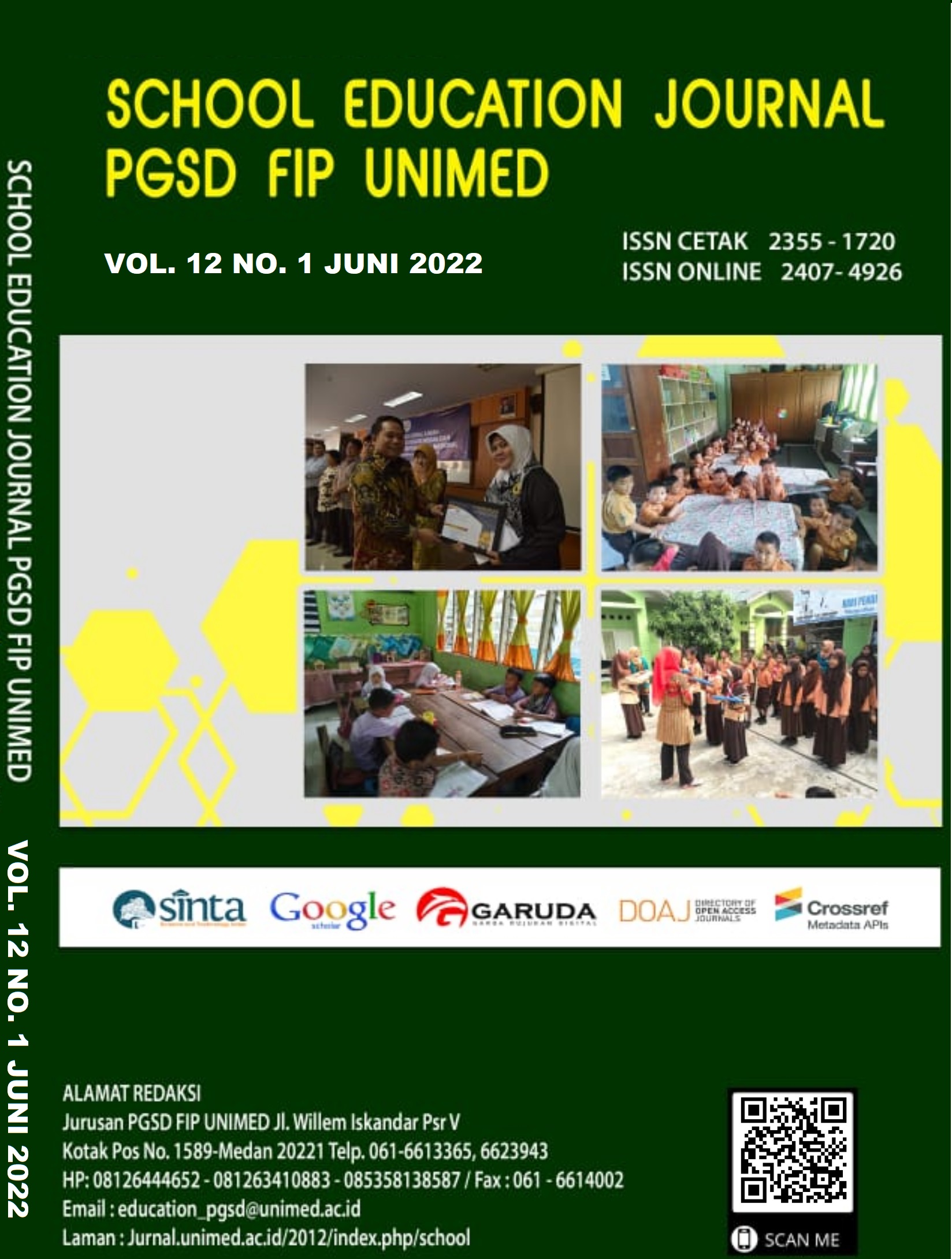IMPLEMENTASI DESAIN MODEL ASSURE DALAM PEMBELAJARAN NOTASI BALOK WARNA UNTUK SISWA KELAS 1 SD
DOI:
https://doi.org/10.24114/sejpgsd.v12i1.35017Keywords:
ASSURE, Block Notation, Color.Abstract
This study aims to develop a teaching material for learning block notation. Based on the results of interviews with several music teachers at private elementary schools in Surabaya, researchers obtained data that there are always students who have difficulty understanding block notation in all private elementary schools that provide block notation material for class students. 1 SD. Therefore, the researcher wants to design a block notation learning material that is interesting and makes it easier for students to understand block notation. The learning design made by the researcher uses the ASSURE model design by paying attention to aspects of child cognitive psychology and color psychology. The results of the design are black block notation images, color block notation images along with hand movements and audio as a unitary block notation teaching material. The results of the design were then tested on grade 1 students at Sampoerna Academy Elementary School and the results showed that 90% of children were interested in the color block notation learning design and it was easier to understand the material.References
Colla, G. (2001). Rainbow Solfege: A Color-Phonic Approach. Teaching Music. 9(2), 32“37. Online publication. Diunduh dari https://eric.ed.gov/?id=EJ660087
Colla, V. C. (2002). Rainbow Solfege: new perspective for color theory and music education. 9th Congress of the International Colour Association. Online publication. DOI: 10.1117/12.464701
Herdinasari,R.T & Sumaryanto, T. (2013). Upaya Meningkatkan Minat dan Hasil Belajar Membaca Notasi Musik Balok Melalui Media Pembelajaran Sibelius Pada Siswa kelas VII G SMP Negeri Unggaran. Jurnal Seni Musik. 2 (2) Halaman 1-5.
Hero, S. G. (2020). Pengembangan Model Pembelajaran Melodi dan Iringan Piano Anak Berbasis Notasi Warna. S2 thesis, Universitas Pendidikan Indonesia. Diunduh dari http://repository.upi.edu/50235/
Hidayatullah, R. (2021). Solfegio: Sebuah pengantar teori musik. Online publication. Diunduh darihttps://www.researchgate.net/publication/355489312_Solfegio_Sebuah_pengantar_teori_musik
Jamalus. (1988). Panduan Pengajaran buku Pengajaran musik melalui pengalaman musik. Jakarta: Proyek pengembangan Lembaga Pendidikan
Jarvis, M. (2011). Teori-Teori Psikologi. Cet. X, Bandung: Nusa Media, hal 142.
Khasanah, D.I.N. (2012). Penerapan Desain Sistem Pembelajaran ASSURE untuk Meningkatkan Hasil Belajar Memukul Bola dalam Permainan Kasti pada Siswa Kelas IV SD Negeri Purworejo Kecamatan Banjarsari Surakarta Tahun Pelajaran 2011/2012. Jurnal Mahasiswa Pendidikan Jasmani Kesehatan Dan Rekreasi. Vol 1, No 1, Hal: 1-17.
Lowenfeld, V., Brittain, W. L. (1987). Creative and Mental Growth. New Jersey: Prentice Hall.
Luehrsen, M. (2005). Sounds of Learning. USA: International Foundation for Music Research.
Luthfiyah Mustaqimatul Ririn. (2020). Meta-Analisis Pengaruh Model Pembelajaran Teams Games Tournament Terhadap Hasil Belajar Di Sekolah Dasar. Medan: SEJ (School Education Journal), 10 (4), 2-97-305.
Marbun A Angel. (2021). Pengaruh Model Pembelajaran Discovery Learning Terhadap Hasil Belajar Siswa Tema Praja Muda Karana Di Kelas III Sd Negeri 105327 Perdamean. Medan: SEJ (School Education Journal), 11 (2), 176-184.
Odbert, H.S., Karwoski, T. F. & Eckerson, A. B. (1942). Studies In Synesthetic Thinking: I. Musical and Verbal Associations of Color and Mood. The Journal of General Psychology. 26:1, 153-173. Online publication. DOI: 10.1080/00221309.1942.10544721
Pribadi, B. (2011). Model ASSURE Untuk Mendesain Pembelajaran Sukses. Jakarta: Dian Rakyat.
Rizdik. (2018). Notasi Warna Untuk Mendukung Contextual Teaching and Learning Style SD Kelas III. Tesis S2 Universitas Negeri Surabaya.
Rogers, G. L. (1996). œEffect of Colored Rhythmic Notation on Music-Reading Skills of Elementary Students. Journal of Research in Music Education, 44(1), 15“25. Online publication. DOI:10.2307/3345410
Syahril, S. (2018) œPengembangan Desain Model ASSURE Pada Pembelajaran IPS SD/MI. Tarbiyah al-Awlad, hal 65“75. Online publication. Diunduh dari https://ejournal.uinib.ac.id/jurnal/index.php/alawlad/article/download/1592/1191
Taylor, A. P. (2017). Newton™s Color Theory, ca.1665. [Online article]. Diunduh dari https://www.the-scientist.com/foundations/newtons-color-theory-ca-1665-31931
The National Association for Music Education. (2002). Benefits of music education. MENC: Author.
Downloads
Published
Issue
Section
License
Authors whose manuscripts are approved are approved as follows:
The publication rights for all journal manuscript materials published/published on the SEJ (School Education Journal) E-Journal site are held by the editorial board with the author's knowledge (moral rights remain with the manuscript authors).
The formal legal requirements for accessing this electronic digital journal article are subject to the terms of the Creative Commons Attribution-ShareAlike (CC BY) license, which means that E-Journal SEJ (School Education Journal) has the right to store, transfer media/format, manage in the form of a database, maintain, and publish articles without asking permission from the author as long as the author's name remains as the copyright owner.
Manuscripts published/published electronically are open access for educational, research, and library purposes.

